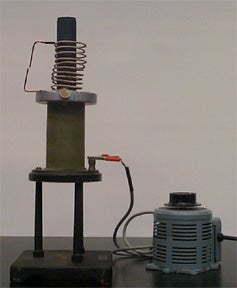-
A loosely wound coil made of thick insulated wire has its tips exposed and touching each other. The coil is slipped on the iron core of an induction coil. The induction coil is connected to an AC power supply. The coil will jump and sparks will be produced at the touching ends.
If the induction coil is connected to a DC power supply and switch instead, one can observe that when the switch is closed, the coil momentarily contracts but only slightly. The current induced when the switch is just closed is relatively small because the inducing field builds up slowly. The sudden collapse of the field when the switch is open induces a much larger current.


-
A large capacitor (240 µF, 5000 V) is used as the supporting stand for a set-up arranged to show the repulsion of currents traveling in opposite directions. Thick plexiglas’s sheets are placed over it and around the set-up consisting of: an electromagnetic switch, a small meter, resistors, and the stand that firmly holds the wide copper strip shaped as shown in the figure. The power supply and a long wire switch are set by its side. The capacitor is charged up during 5-10 minutes at 2000 V DC through a resistor R = 1.8 x 106 ohm (or until the meter indicates at least 15-20 mA). Turn the power supply off. Take the switch and step away from the apparatus. Close and open the remote switch. When the circuit is closed, the capacitor will discharge through the copper strip. The electric current goes up and down the strip causing the sides to be strongly repelled and deformed. It is loud and certainly an eye-opener.
Instead of the copper strip, one can set between stand’s poles a puffed up cylinder made of aluminum foil cut into narrow strips along its midsection. The electromagnetic forces will constrict the sliced part of the foil greatly.


-
Using the same induction coil arrangement as that for the “Jumping Ring” demonstration, one can demonstrate the attraction between two metal rings where the induced currents are in phase all the time.
Turn the current on, the slip the copper ring over the core and allow it to drop. The ring remains suspended above the coil. Next slip the aluminum ring over the core and hold it some distance above the copper ring. The copper ring is attracted upward to the aluminum ring. If the two are left floating freely together on the core, they cling together. However, both are repelled by the induction coil since the current in it at any instant is always in opposite phase to the current in the rings.


Force between Current Carrying Conduct
Contact our lab
Visit Us
USC Physics Lecture Support Lab SLH (Stauffer Lecture Hall) – 104
Department of Physics and Astronomy
University of Southern California
Los Angeles
Questions or Comments
If you have questions or comments e-mail us or call at phone number below.